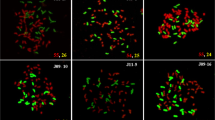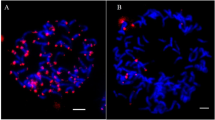Abstract
Molecular markers were used to characterise sugarcane intergeneric hybrids between S. officinarum and E. arundinaceus. Very simple diagnostic tools for hybrid identification among the progeny were derived from isozyme electrophoresis and a sequence-tagged PCR. Two enzyme systems (GOT and MDH B) and PCR amplification revealing spacer-size variation in the 5s-rDNA cluster were found most convenient. Specific characterisation of the two genomic components was possible using RFLP and in situ hybridisation. The strong molecular differentiation between S. officinarum and E. arundinaceus allows the identification of numerous Erianthus-specific RFLP bands in the hybrids. Genomic DNA in situ hybridisation allows for the differentiation of the chromosomes contributed by S. officinarum and E. arundinaceus in chromosome preparations of the hybrids. In situ hybridisation with the 18s-5.8s-25s rDNA probe highlights the basic chromosome numbers in the two parental species. The potential of these techniques to monitor the Erianthus genome during the introgression process is discussed.
Similar content being viewed by others
References
Arceneaux G (1965) Cultivated sugarcanes of the world and their botanical derivation. Proc Int Soc Sugar Cane Technol 12: 844–854
Berding N, Roach BT (1987) Germplasm collection, maintenance, and use. In: Heinz DJ (ed) Sugarcane improvement through breeding. Elsevier Press, Amsterdam, pp 143–210
Cox AC, Bennett MD, Dyer TA (1992) Use of the polymerase chain reaction to detect spacer size heterogeneity in plant 5s rRNA gene clusters and to locate such clusters in wheat (Triticum aestivum L.). Theor Appl Genet 83:684–690
D'Hont A, Lu YH, Feldmann P, Glaszmann JC (1993) Cytoplasmic diversity in sugar cane revealed by heterologous probes. Sugar Cane 1:12–15
D'Hont A, Lu YH, Gonzalez de Leon D, Grivet L, Feldmann P, Lanaud C, Glaszmann JC (1994) A molecular approach to unravelling the genetics of sugarcane, a complex polyploid of the Andropogoneae tribe. Genome 37:222–230
Dvorak J, Zhang HB, Kota RS, Lassner M (1989) Organisation and evolution of the 5s ribosomal RNA gene family in wheat and related species. Genome 32:1003–1016
Feldmann P (1984) Analyse du polymorphisme enzymatique de la canne à sucre (Saccharum sp.): utilisation pour la recherche de variabilité après cutlture in vitro. Thèse, Université de Paris-Sud, Orsay
Gerlach WL, Bedbrook JR (1979) Cloning and characterisation of ribosomal RNA genes from wheat and barley. Nucleic Acids Res 7:1869–1885
Glaszmann JC, Noyer JL, Fautret A, Feldmann P, Lanaud C (1989) Biochemical genetic markers in sugarcane. Theor Appl Genet 78:537–543
Heslop-Harrison JS, Schwarzacher T, Leitch AR, Leitch IJ, Anamthawat-Jonsson K, Mosgoller W, Maluszynska J, Shi M (1991) In situ hybridisation. Karyobiology Group. J.I. Institute, Norwich UK
Heslop-Harrison JS, Harrison GE, Leitch IJ (1992) Re-probing of DNA:DNA in situ hybridization preparations. Trends Genet 8: 372–373
Hoisington D (1992) Laboratory protocols. CIMMYT applied molecular genetics laboratory, CIMMYT, Mexico, D.F.
Klimyuk VI, Carroll BJ, Thomas CM, Jones JDG (1993) Alkali treatement for rapid preparation of plant material for reliable PCR analysis. Plant J 3:493–494
Lu YH, D'Hont A, Walker DIT, Rao PS, Feldmann P, Glaszmann JC (1994) Relationships among ancestral species of sugarcane revealed with RFLP using single-copy maize nuclear probes. Euphytica 78:7–18
McIntyre CL, Winberg B, Houchins K, Appels R, Baum BR (1992) Relationships between Oryza species (Poaceae) based on 5s DNA sequences. Pl Syst Evol 183:249–264
Moran GF, Smith, D, Bell JC, Appels R (1992) The 5s RNA genes in Pinus radiata and the spacer region as a probe for relationships between Pinus species. Pl Syst Evol 183:209–221
Price S (1965) Interspecific hybridization in sugarcane breeding. Proc Int Soc Sugar Cane Technol 12:1021–1026
Roach B T, Daniels J (1987) A review of the origin and improvement of sugarcane. In: Copersucar Int Sugarcane Breed Workshp Copersucar, Sao Paulo, pp 1–31
Sreenivasan TV, Ahloowalia BS, Heinz DJ (1987) Cytogenetics. In: Heinz DJ (ed) Sugarcane improvement through breeding. Elsevier Press, Amsterdam, pp 211–253
Sobral BWS, Braga DPV, Lahood ES, Keim P (1994) Phylogenetic analysis of chloroplast restriction enzyme site mutations in the Saccharinae Griseb. subribe of the Andropogoneae Dumort. tribe. Theor Appl Genet 87:843–853
Shaw CR, Prasad R (1970) Starch-gel electrophoresis of enzymes, a compilation of recipes. Biochem Genet 4:297–230
Walker DIT (1987) Manipulating the genetic base of sugarcane. In: Copersucar Int Sugarcane Breed Workshp Copersucar, Sao Paulo, pp 321–334
Author information
Authors and Affiliations
Additional information
Communicated by H. F. Linskens
Rights and permissions
About this article
Cite this article
D'Hont, A., Rao, P.S., Feldmann, P. et al. Identification and characterisation of sugarcane intergeneric hybrids, Saccharum officinarum x Erianthus arundinaceus, with molecular markers and DNA in situ hybridisation. Theoret. Appl. Genetics 91, 320–326 (1995). https://doi.org/10.1007/BF00220894
Received:
Accepted:
Issue Date:
DOI: https://doi.org/10.1007/BF00220894




